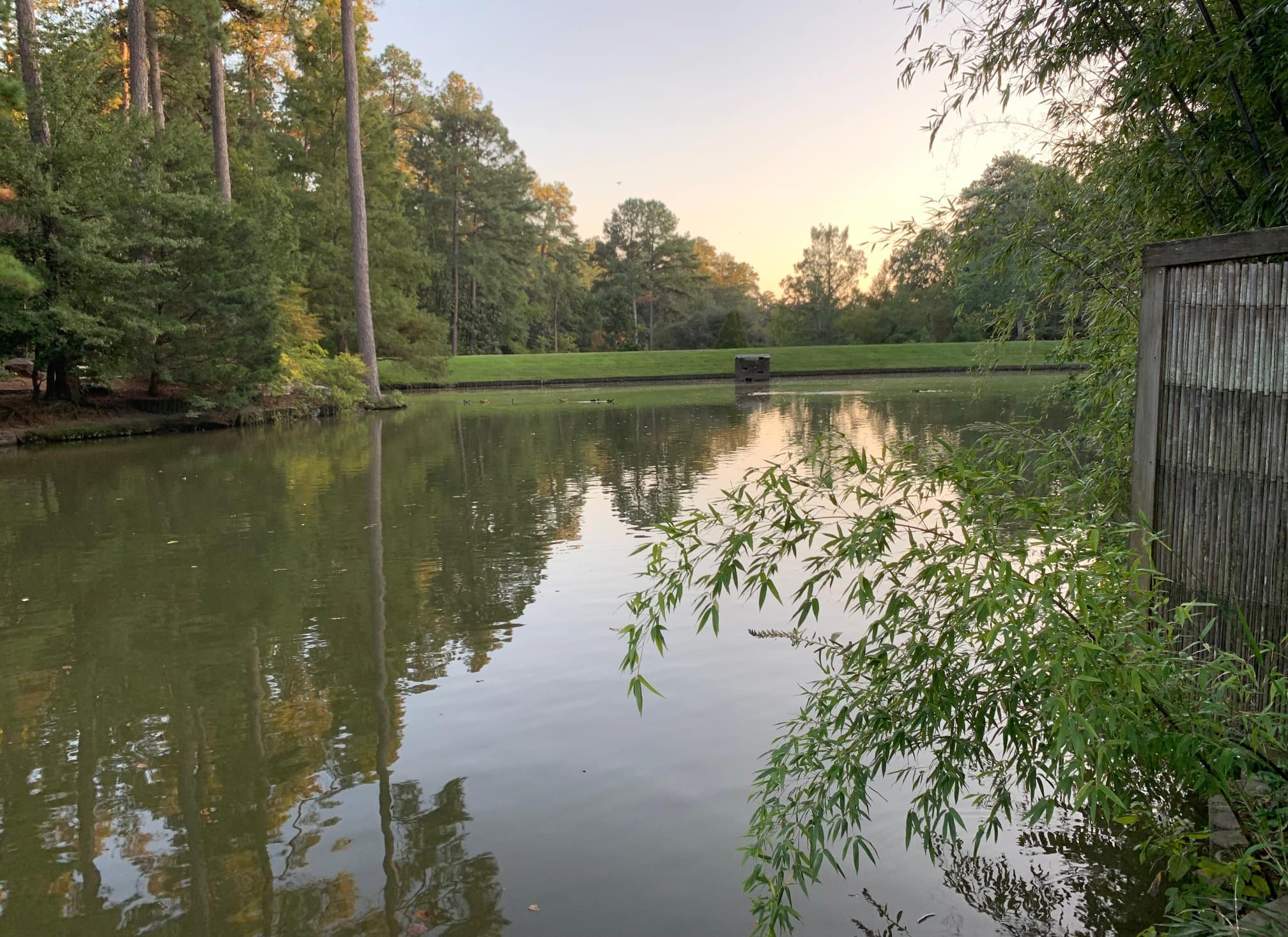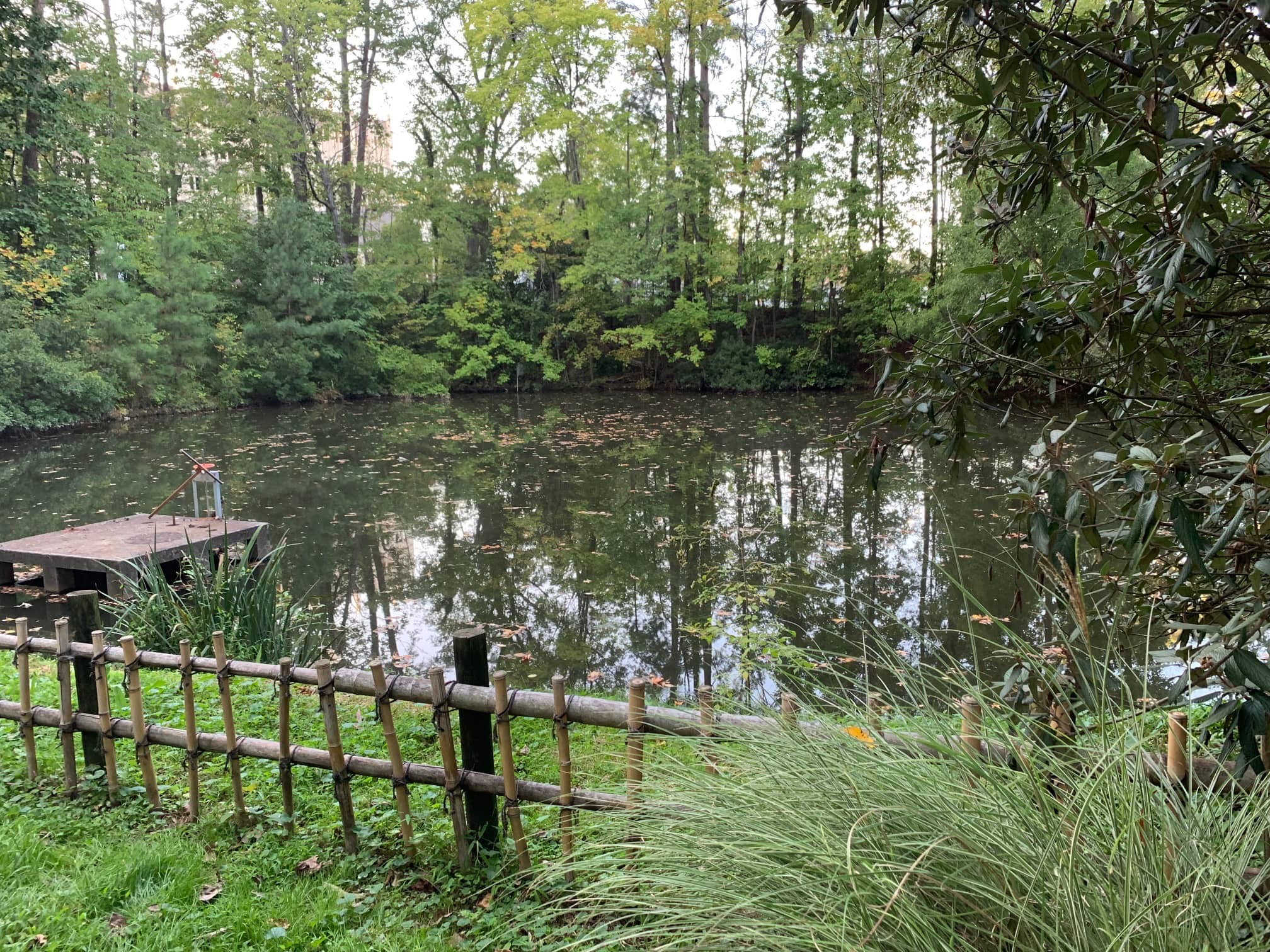Growing with the Flow
Managing Stormwater in a Changing Climate
by Katherine Hale
Rainy days in Duke Gardens have their own beauty, but they also come with unique challenges beyond wet feet or the need for umbrellas, in that every drop of water has to go somewhere. For light rains, this isn’t a problem—the water is quickly absorbed into the soil or taken up by plants. But heavier stormswill drop water more quickly than the ground or vegetation can hold, forcing it to pool along the surface in search of the lowest point in the landscape. This excess water, known as stormwater runoff (stormwater for short), can quickly become a problem, overflowing across roads and paths or even washing them out completely, and damaging plants, slopes and structures.
Stormwater has been a constant challenge from the earliest days of Duke Gardens, beginning in 1935, when flooding washed out thousands of bulbs planted in what is now the South Lawn and inspiring the creation of the Terrace Gardens. Now, climate change is bringing heavier and more frequent rains that dump huge volumes of water with little or no warning. With the increasing amount of paved and impermeable surfaces in the surrounding 300-acre watershed that drains into the Gardens, including much of the Duke University campus, the need for safe and effective on-site stormwater management has never been greater.


This is compounded further by the historic nature of the Gardens, where much of the current infrastructure predates both the recent climate shifts and modern building codes, and by the high levels of pollution, trash and sediment carried along with the runoff, all of which are problematic in their own right. As a result, updating and expanding these systems for the future is one of horticulture director Bobby Mottern’s most pressing tasks for the coming years—as well as a tremendous opportunity for both Duke Gardens and the larger environment.
“Stormwater has been part of the history of the Gardens since day one, and it will continue to be. It’s not something we’re ever going to try to stop,” Mottern explains. “Every time we renovate a space, we’re trying to think about how water moves through that space, how we can slow water down, how we can keep water on the surface, because we don’t want to put water in pipes unless we absolutely have to.”
Regardless of its original source, a large percentage of the stormwater entering Duke Gardens arrives first at the North Pond in the Culberson Asiatic Arboretum along Yearby Avenue. The pond is a forebay, an artificial pool that buffers the larger pond immediately downstream, keeping it from overflowing, and filtering out trash and sediment. Because it receives such a high volume of silt during heavy rains, the North Pond must be dredged every five to 10 years in order to keep it from gradually filling in over time. Unfortunately, a significant amount of soil still reaches the main pond, which has only been dredged once in the 40 years since it was first dug. This dredging will be a necessary first step in the Gardens’ overall plan for long-term stormwater improvements.
These two ponds are separated from each other by a large earthen dam with a gravel path on top that connects visitors to the adjacent Ruth Mary Meyer Japanese Garden. A similar structure separates the main arboretum pond from the Hanes Lawn, Iris Bridge and Fisher Amphitheater and marks the boundary with the Historic Gardens. Because both of these dams predate modern building codes and thus lack emergency overflow features, in a worst-case scenario, a sufficiently large storm could significantly destabilize these dams, or even blow one or both out completely due to erosion from floodwaters. To prevent this from happening, Mottern is working closely with Duke University Facilities Management and the North Carolina Department of Transportation on a plan to renovate the dams to keep them safe and functional during these increasingly common high-water events.
Once stormwater passes the Iris Bridge, it continues above ground in an open stream (“daylighted” in engineering terms) until it reaches the Terrace Gardens, where it is piped underground, eventually emerging on the very edge of Duke Gardens in the South Lawn pond, which is lined with aquatic plants that filter and clean the water before it moves off site. From there, the stream continues under Flowers Drive and across campus until it joins with Sandy Creek in Duke Forest and, eventually, the Cape Fear River and the Atlantic Ocean.
Although this is the most common path for stormwater in Duke Gardens, it is far from the only one. Water collected in the cisterns and bioswales in the Charlotte Brody Discovery Garden is used to irrigate vegetables and support a thriving rain garden. They were also a major factor in the Brody garden’s certification by the Sustainable SITES Initiative. Many of the paths throughout the Gardens are bordered by rocky swales created by master stonemason Brooks Burleson, which are designed to channel excess water in the appropriate directions while allowing as much of it as possible to infiltrate the soil through the gaps between the stones.
The renovation of the Sunny Pond in the Blomquist Garden of Native Plants this winter will address the long-term problem of off-site runoff from surrounding hardscapes while simultaneously expanding the garden’s carnivorous plant collection. Stormwater management is also an important design consideration for the forthcoming $30 million Garden Gateway project. Rainwater from the rooftops of the expanded visitor center will be collected in cisterns for horticultural use, while water that falls on the parking lot will be directed into additional rain gardens along Anderson Street and what is currently the service area of the Blomquist Garden.
Regardless of the size or scale, the goal in each of these diverse but connected projects is the same—the seamless integration of stormwater into Duke Gardens through systems that are simultaneously functional, ecological and visually appealing. They are also a part of the Duke Climate Commitment’s long-term goals for sustainable operations, as well as external engagement and education with the larger community in Durham and the Cape Fear River watershed.



